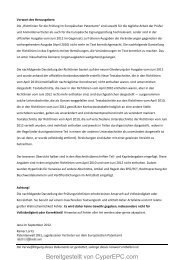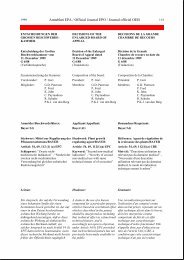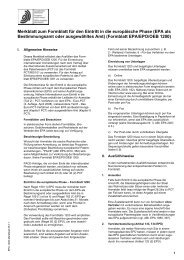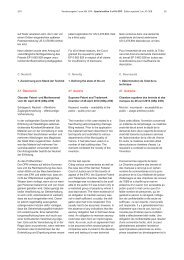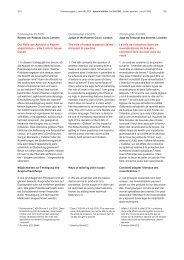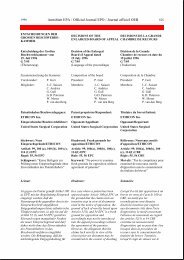Sonderausgabe 3 zum ABl. EPA 2011/107 - CyberEPC
Sonderausgabe 3 zum ABl. EPA 2011/107 - CyberEPC
Sonderausgabe 3 zum ABl. EPA 2011/107 - CyberEPC
Create successful ePaper yourself
Turn your PDF publications into a flip-book with our unique Google optimized e-Paper software.
<strong>2011</strong> <strong>Sonderausgabe</strong> 3 <strong>zum</strong> <strong>ABl</strong>. <strong>EPA</strong> Special edition 3 of OJ EPO Edition spéciale 3 du JO OEB 125In einigen Fällen erübrige sich eine ausgeklügelteAuslegung, da die Idee ohnehinziemlich offensichtlich sei. In anderenFällen sei es praktisch gar nicht möglich,eine Idee zu ermitteln, beispielsweise beieinem Anspruch auf eine Klasse chemischerVerbindungen. Bei der Ermittlungder erfinderischen Idee sei die Berücksichtigungdes Stands der Technik fehlam Platz.Die überarbeitete Prüfung auf Naheliegenstellt sich somit wie folgt dar:1. a) Ermittlung des "Durchschnittsfachmanns"1. b) Ermittlung des einschlägigen allgemeinenFachwissens dieses FachmannsIn some cases one did not need to gointo the finer points of construction, theconcept being fairly apparent without.In yet other cases it was not even practicableto try to identify a concept, forexample a chemical class claim. Identificationof the concept was not the placeto take into account the prior art.The revised test for obviousness wasthus:1. (a) Identify the notional "person skilledin the art";1. (b) Identify the relevant commongeneral knowledge of that person;Dans certains cas, on n'a pas besoind'entrer dans les subtilités de l'interprétation: le concept est suffisamment apparent.Dans d'autres cas, il est même difficilede chercher à identifier un concept,par exemple pour une revendicationportant sur une catégorie de produitschimiques. Ce n'est pas au niveau del'identification du concept que l'on prenden compte l'état de la technique.En conséquence, le nouveau test pourapprécier le caractère évident de l'inventionest le suivant :1. (a) Identification de "l'homme dumétier" théorique1. (b) Identification des connaissancesgénérales pertinentes de cette personne ;2. Ermittlung der dem betreffenden Anspruchzugrunde liegenden erfinderischenIdee und, wenn dies nicht ohne Weiteresmöglich ist, Auslegung des Anspruchs3. Ermittlung etwaiger Unterschiedezwischen dem als Stand der Technikangegebenen Gegenstand und derdem Anspruch bzw. dem ausgelegtenAnspruch zugrunde liegenden erfinderischenIdee4. Klärung der Frage, ob es sich beidiesen Unterschieden, wenn man sie inUnkenntnis der beanspruchten angeblichenErfindung betrachtet, um für denFachmann naheliegende Schritte handeltoder ob sie <strong>zum</strong>indest bis zu einemgewissen Grad erfinderisch sindDer Patentinhaber versuchte seine Erfindunggegen den Vorwurf des Naheliegensdamit zu verteidigen, dass gegensie ein technisches Vorurteil bestandenhabe ("ein Löwe auf dem Weg"). DerCourt of Appeal stellte folgende Überlegungenan:– Ein Patentinhaber, der etwas Neuesbeisteuert, indem er zeigt, dass eineIdee entgegen einem irrigen Vorurteilfunktioniert oder praktisch umsetzbar ist,hat etwas Neues aufgezeigt. In diesemFall ist der Löwe auf dem Weg nichtsweiter als ein Papiertiger.– Ein Patentinhaber, der lediglich einealte Idee patentieren lässt, von der mandachte, sie würde nicht funktionierenoder sei nicht umsetzbar, und nichterklärt, weshalb oder wie sie entgegendem Vorurteil funktioniert oder sich um-2. Identify the inventive concept of theclaim in question or, if that cannot readilybe done, construe it;3. Identify what, if any, differences existbetween the matter cited as forming partof the "state of the art" and the inventiveconcept of the claim or claim asconstrued;4. Viewed without any knowledge of thealleged invention as claimed, do thosedifferences constitute steps which wouldhave been obvious to the person skilledin the art or do they require any degreeof invention?The patentee sought to defend hisinvention from a charge of obviousnessby saying that there was a technicalprejudice against it ("a lion in the path").The Court of Appeal reasoned that:– A patentee who contributed somethingnew by showing that, contrary to themistaken prejudice, the idea would workor was practical had shown somethingnew. In this case the lion in the path wasmerely a paper tiger.– A patentee who merely patented anold idea thought not to work or to bepractical and did not explain how or why,contrary to the prejudice, that it did workor was practical, contributed nothing tohuman knowledge. The lion remained2. Identification du concept inventif de larevendication en question ou, si celan'est pas possible d'emblée, identificationpar interprétation de la revendication ;3. Identification des différences qui, lecas échéant, existent entre l'objet citécomme faisant partie de "l'état de latechnique" et le concept inventif de larevendication ou de la revendication tellequ'interprétée ;4. Examen de la question visant à savoirsi ces différences, considérées sansaucune connaissance de la prétendueinvention telle que revendiquée, constituentdes étapes qui auraient été évidentespour l'homme du métier ou si ellessupposent nécessairement une quelconqueactivité inventive.Le titulaire du brevet a cherché à défendreson invention contre une allégationde caractère évident, en soutenant qu'il yavait un préjugé technique à son encontre.Selon le raisonnement de la Courd'appel :– un titulaire de brevet apportant quelquechose de nouveau en montrant que,contrairement à un préjugé erroné, l'idéeest fonctionnelle ou pratique, apporteeffectivement quelque chose denouveau. Dans ce cas, le préjugé n'aaucune valeur.– un titulaire de brevet qui se contentede breveter une idée ancienne dont onpensait qu'elle n'était pas fonctionnelleou pratique et qui n'explique pascomment ou pourquoi, contrairement aupréjugé, cette idée fonctionne effective-



